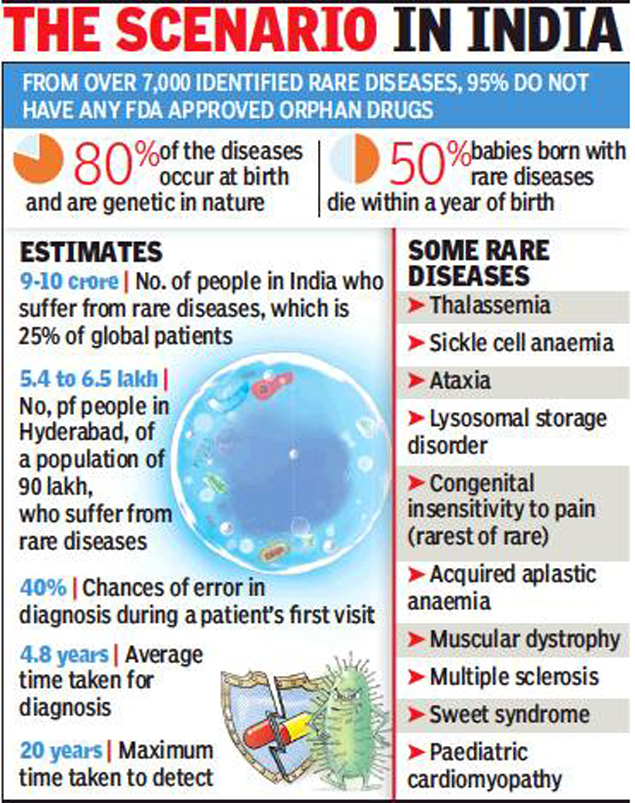Context:
Recently, a Rajya Sabha Member of Parliament (MP) raised concerns over National Policy of Rare Diseases (NPRD) as it did not reach any patient with rare diseases even after several months since its introduction.
Relevance:
GS-II: Social Justice (Health related issues, Governance and Government Policies, Issues Arising Out of Design & Implementation of Policies)
Dimensions of the Article:
- What are ‘Rare diseases’?
- Pressing Issues regarding ‘Rare diseases’
- Provisions of the National Rare Disease Policy 2021
- Criticisms of the National Rare Disease Policy 2021
- Constitutional Provisions in the context of the new policy for rare diseases
What are ‘Rare diseases’?
A rare disease, also referred to as an orphan disease, is any disease that affects a small percentage of the population.
Most rare diseases are genetic, and are present throughout a person’s entire life, even if symptoms do not immediately appear.
- Haemophilia,
- Thalassemia,
- Sickle-cell anaemia,
- Auto-immune diseases,
- Pompe disease,
- Hirschsprung disease,
- Gaucher’s disease,
- Cystic Fibrosis,
- Hemangiomas and
- Certain forms of muscular dystrophies
Are some of the most common rare diseases recorded in India.
Pressing Issues regarding ‘Rare diseases’
- Rare diseases pose a significant challenge to health care systems because of the difficulty in collecting epidemiological data, which in turn impedes the process of arriving at a disease burden, calculating cost estimations and making correct and timely diagnoses, among other problems.
- There are 7,000-8,000 classified rare diseases, but less than 5% have therapies available to treat them.
- About 95% rare diseases have no approved treatment and less than 1 in 10 patients receive disease-specific treatment. Where drugs are available, they are prohibitively expensive, placing immense strain on resources.
- These diseases have differing definitions in various countries and range from those that are prevalent in 1 in 10,000 of the population to 6 per 10,000.
- India has said it lacks epidemiological data on the prevalence here and hence has only classified certain diseases as ‘rare.’
- Currently, only a few pharmaceutical companies are manufacturing drugs for rare diseases globally and there are no domestic manufacturers in India except for those who make medical-grade food for those with metabolic disorders.
- Due to the high cost of most therapies, the government has not been able to provide these for free.

Provisions of the National Rare Disease Policy 2021
- Patients of rare diseases will be eligible for a one-tome treatment under the Ayushman Bharat Pradhan Mantri Jan Arogya Yojana (AB-PMJAY).
- Financial support up to Rs20 lakh under the Umbrella Scheme of Rashtriya Arogaya Nidhi shall be provided by the central government for treatment of those rare diseases that require a one-time treatment (diseases listed under Group 1) for their treatment in Government tertiary hospitals only. – (NOT be limited to below poverty line (BPL) families, but extended to about 40% of the population as eligible under the norms of Pradhan Mantri Jan Arogya Yojana (PMJAY))
The policy has categorised rare diseases in three groups:
- Disorders amenable to one-time curative treatment;
- Those requiring long term or lifelong treatment; and
- Diseases for which definitive treatment is available but challenges are to make optimal patient selection for benefit.
The government has said that it will also assist in voluntary crowd-funding for treatment as it will be difficult to fully finance treatment of high-cost rare diseases.
Criticisms of the National Rare Disease Policy 2021
- Though the document specifies increasing the government support for treating patients with a ‘rare disease’— from Rs 15 lakh to Rs 20 lakh — caregivers say this doesn’t reflect actual costs of treatment.
- The Policy leaves patients with Group 3 rare diseases to fend for themselves due to the absence of a sustainable funding support.
- What the policy doesn’t capture is that these are diseases that last a lifetime adding up to a huge amount of expenditure and many of the patients who can’t afford such treatment will be unable to even make it to the prescribed tertiary hospitals for treatment.
Constitutional Provisions in the context of the new policy for rare diseases
- Article 38 says that the state will secure a social order for the promotion of welfare of the people. Providing affordable healthcare is one of the ways to promote welfare.
- Article 41 imposes duty on state to provide public assistance in cases of unemployment, old age, sickness and disablement etc.
- Article 47 makes it the duty of the State to improve public health, securing of justice, human condition of works, extension of sickness, old age, disablement and maternity benefits and also contemplated.
-Source: The Hindu




